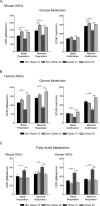Altered metabolic and stemness capacity of adipose tissue-derived stem cells from obese mouse and human
- PMID: 25875023
- PMCID: PMC4395137
- DOI: 10.1371/journal.pone.0123397
Altered metabolic and stemness capacity of adipose tissue-derived stem cells from obese mouse and human
Abstract
Adipose stem cells (ASCs) are an appealing source of cells for therapeutic intervention; however, the environment from which ASCs are isolated may impact their usefulness. Using a range of functional assays, we have evaluated whether ASCs isolated from an obese environment are comparable to cells from non-obese adipose tissue. Results showed that ASCs isolated from obese tissue have a reduced proliferative ability and a loss of viability together with changes in telomerase activity and DNA telomere length, suggesting a decreased self-renewal capacity. Metabolic analysis demonstrated that mitochondrial content and function was impaired in obese-derived ASCs resulting in changes in favored oxidative substrates. These findings highlight the impact of obesity on adult stem properties. Hence, caution should be exercised when considering the source of ASCs for cellular therapies since their therapeutic potential may be impaired.
Conflict of interest statement
Figures







References
Publication types
MeSH terms
Substances
LinkOut - more resources
Full Text Sources
Other Literature Sources
Medical

